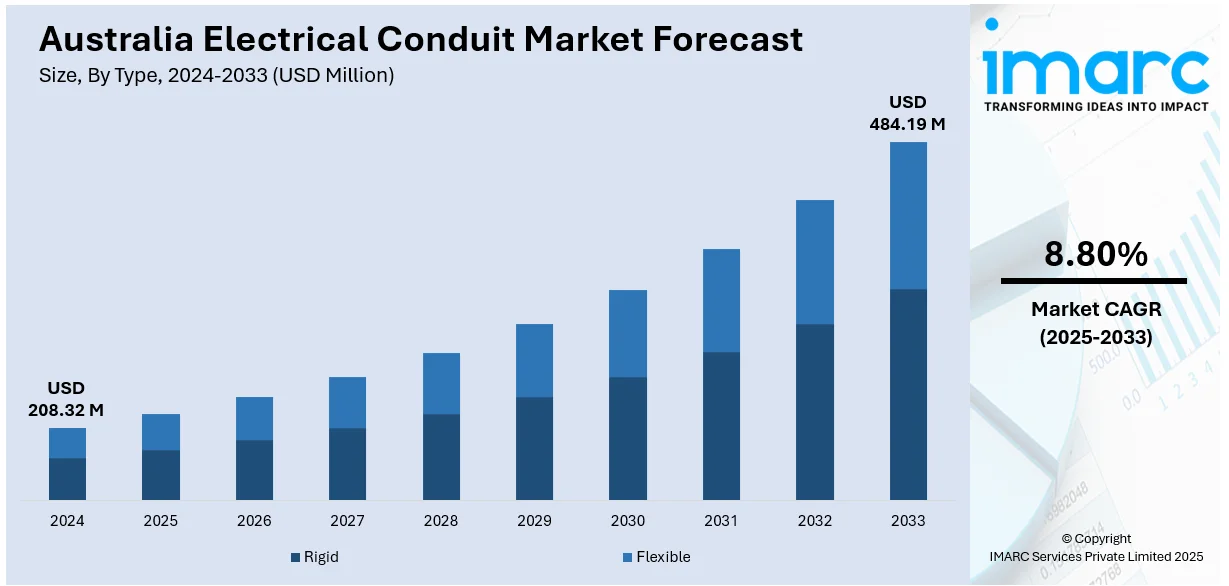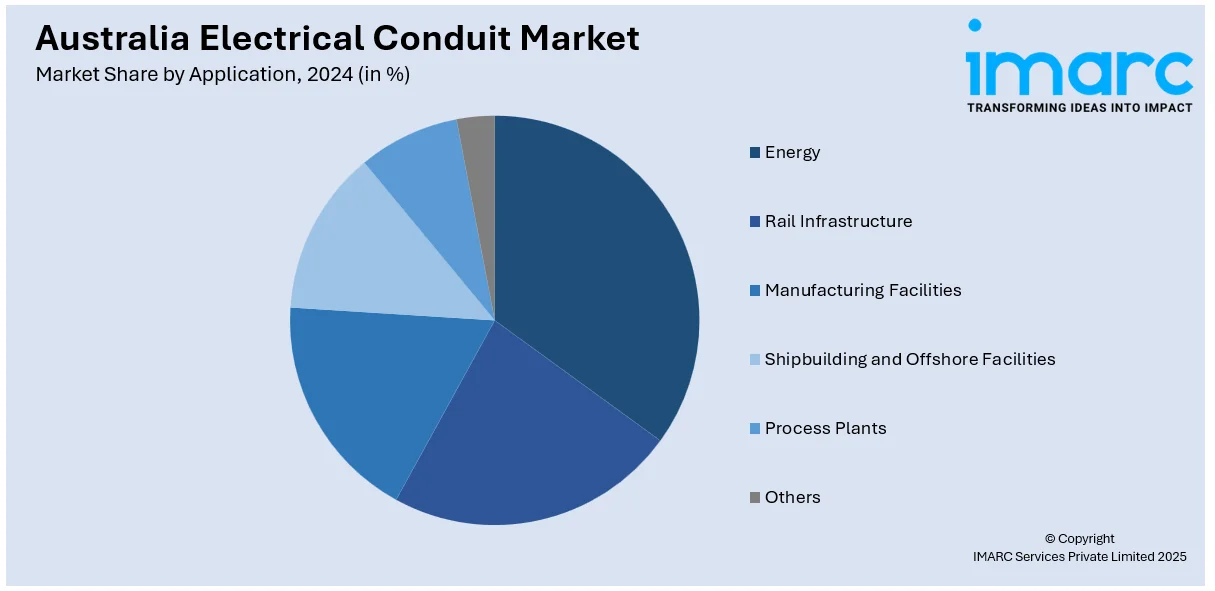
Australia Electrical Conduit Market Size, Share, Trends and Forecast by Type, Material, Application, and Region, 2025-2033
Australia Electrical Conduit Market Overview:
The Australia electrical conduit market size reached USD 208.32 Million in 2024. Looking forward, IMARC Group expects the market to reach USD 484.19 Million by 2033, exhibiting a growth rate (CAGR) of 8.80% during 2025-2033. The market is driven by increasing infrastructure development, the demand for energy-efficient solutions, and regulatory requirements for safety. As urbanization grows, the Australia electrical conduit market share continues to expand with innovations in materials, thereby supporting both residential and industrial construction sectors.
|
Report Attribute
|
Key Statistics
|
|---|---|
|
Base Year
|
2024
|
|
Forecast Years
|
2025-2033
|
|
Historical Years
|
2019-2024
|
| Market Size in 2024 | USD 208.32 Million |
| Market Forecast in 2033 | USD 484.19 Million |
| Market Growth Rate 2025-2033 | 8.80% |
Australia Electrical Conduit Market Trends:
Increasing Demand for Certified Electrical Solutions
The market is witnessing a growing emphasis on safety and certification, as demand for high-quality, compliant products rises. This trend is driven by the need to meet stringent regulatory standards and to ensure secure, reliable installations. As construction and infrastructure projects become more complex, the adoption of certified solutions like IEC and ASNZS-compliant products has become essential for ensuring safety and functionality in electrical systems. Aligned with this trend, in July 2024, Ledes, a leading player in the market, expanded its presence in Australia and New Zealand by offering IEC and ASNZS-certified electrical conduit products. This moved reinforced safety standards and introduced innovative solutions tailored to meet the evolving needs of the electrical installation sector. By complying with international standards, Ledes’ products address the increasing demand for quality and reliability, which is critical for both residential and industrial projects. This market development not only reinforced Ledes’ dominance but also contributed significantly to improving the overall safety of electrical installations. With an ongoing emphasis on meeting compliance standards and adopting advanced products, the Australian electrical conduit market growth is poised to continue expanding, as the industry places higher value on certified solutions to meet regulatory requirements and enhance safety across all sectors.

To get more information on this market, Request Sample
Advancements in Installation Efficiency and Cost Savings
The Australian market is increasingly focused on innovations that drive installation efficiency and reduce labor costs. As construction projects grow more complex and require faster completion, contractors and installers are seeking out solutions that can streamline operations and optimize timelines, ultimately resulting in significant cost savings. Time-saving innovations are now seen as a key driver of competitiveness within the industry. For instance, in March 2025, ABB launched its new Carlon polycarbonate ENT two-piece fittings, a product designed specifically to enhance installation efficiency. These fittings, intended for poured-in-place concrete construction, were engineered to deliver over 20% labor savings compared to traditional fittings. By simplifying the installation process and offering better durability, these fittings represent a leap forward in reducing both installation time and associated costs. This development has a profound impact on the Australian market, as electrical contractors increasingly seek solutions that reduce manual labor and improve efficiency. The widespread adoption of these cost-saving products will likely fuel the market’s growth, especially as demand for faster, more economical electrical installations continues to rise in both residential and commercial sectors. With these ongoing advancements, the market is likely to witness a shift towards faster and more cost-effective solutions, creating opportunities for continued innovation in electrical conduit technologies.
Australia Electrical Conduit Market Segmentation:
IMARC Group provides an analysis of the key trends in each segment of the market, along with forecasts at the country and regional level for 2025-2033. Our report has categorized the market based on type, material, and application.
Type Insights:
- Rigid
- Flexible
The report has provided a detailed breakup and analysis of the market based on the type. This includes rigid and flexible.
Material Insights:
- Metallic
- Non-Metallic
The report has provided a detailed breakup and analysis of the market based on the material. This includes metallic and non-metallic.
Application Insights:

- Energy
- Rail Infrastructure
- Manufacturing Facilities
- Shipbuilding and Offshore Facilities
- Process Plants
- Others
A detailed breakup and analysis of the market based on the application have also been provided in the report. This includes energy, rail infrastructure, manufacturing facilities, shipbuilding and offshore facilities, process plants, and others.
Regional Insights:
- Australia Capital Territory & New South Wales
- Victoria & Tasmania
- Queensland
- Northern Territory & Southern Australia
- Western Australia
The report has also provided a comprehensive analysis of all the major regional markets, which include Australia Capital Territory & New South Wales, Victoria & Tasmania, Queensland, Northern Territory & Southern Australia, and Western Australia.
Competitive Landscape:
The market research report has also provided a comprehensive analysis of the competitive landscape. Competitive analysis such as market structure, key player positioning, top winning strategies, competitive dashboard, and company evaluation quadrant has been covered in the report. Also, detailed profiles of all major companies have been provided.
Australia Electrical Conduit Market News:
- May 2025: Jacobs was appointed as the Integrated Delivery Partner for Marinus Link, a 345-km HVDC interconnector between Tasmania and Victoria. This project will boost renewable energy transmission, creating demand for advanced electrical conduit systems, supporting growth in Australia’s energy infrastructure market.
- March 2025: Syncline Energy proposed a 265 km underground HVDC transmission cable in Victoria, eliminating the need for traditional poles and wires. This innovation aims to enhance electricity distribution, reduce community impact, and support renewable energy growth, impacting the Australian electrical conduit market positively.
Australia Electrical Conduit Market Report Coverage:
| Report Features | Details |
|---|---|
| Base Year of the Analysis | 2024 |
| Historical Period | 2019-2024 |
| Forecast Period | 2025-2033 |
| Units | Million USD |
| Scope of the Report |
Exploration of Historical Trends and Market Outlook, Industry Catalysts and Challenges, Segment-Wise Historical and Future Market Assessment:
|
| Types Covered | Rigid, Flexible |
| Materials Covered | Metallic, Non-Metallic |
| Applications Covered | Energy, Rail Infrastructure, Manufacturing Facilities, Shipbuilding and Offshore Facilities, Process Plants, Others |
| Regions Covered | Australia Capital Territory & New South Wales, Victoria & Tasmania, Queensland, Northern Territory & Southern Australia, Western Australia |
| Customization Scope | 10% Free Customization |
| Post-Sale Analyst Support | 10-12 Weeks |
| Delivery Format | PDF and Excel through Email (We can also provide the editable version of the report in PPT/Word format on special request) |
Key Questions Answered in This Report:
- How has the Australia electrical conduit market performed so far and how will it perform in the coming years?
- What is the breakup of the Australia electrical conduit market on the basis of type?
- What is the breakup of the Australia electrical conduit market on the basis of material?
- What is the breakup of the Australia electrical conduit market on the basis of application?
- What is the breakup of the Australia electrical conduit market on the basis of region?
- What are the various stages in the value chain of the Australia electrical conduit market?
- What are the key driving factors and challenges in the Australia electrical conduit market?
- What is the structure of the Australia electrical conduit market and who are the key players?
- What is the degree of competition in the Australia electrical conduit market?
Key Benefits for Stakeholders:
- IMARC’s industry report offers a comprehensive quantitative analysis of various market segments, historical and current market trends, market forecasts, and dynamics of the Australia electrical conduit market from 2019-2033.
- The research report provides the latest information on the market drivers, challenges, and opportunities in the Australia electrical conduit market.
- Porter's five forces analysis assist stakeholders in assessing the impact of new entrants, competitive rivalry, supplier power, buyer power, and the threat of substitution. It helps stakeholders to analyze the level of competition within the Australia electrical conduit industry and its attractiveness.
- Competitive landscape allows stakeholders to understand their competitive environment and provides an insight into the current positions of key players in the market.
Need more help?
- Speak to our experienced analysts for insights on the current market scenarios.
- Include additional segments and countries to customize the report as per your requirement.
- Gain an unparalleled competitive advantage in your domain by understanding how to utilize the report and positively impacting your operations and revenue.
- For further assistance, please connect with our analysts.
 Request Customization
Request Customization
 Speak to an Analyst
Speak to an Analyst
 Request Brochure
Request Brochure
 Inquire Before Buying
Inquire Before Buying




.webp)




.webp)












